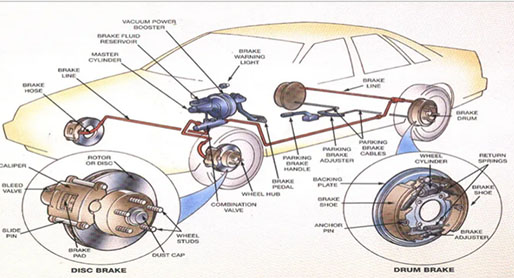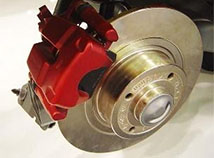Vehicle Brake Test and it’s importance
What Is A Brake?
A brake is a mechanical device that inhibits motion by absorbing energy from a moving system. It is used for slowing or stopping a moving vehicle, wheel, axle, or to prevent its motion, most often accomplished by means of friction.
Most brakes commonly use friction between two surfaces being compressed to convert the kinetic energy of the moving object into heat, although other methods of converting energy can be used. For example, regenerative braking converts much of the energy into electrical energy that can be stored for later use.Other methods convert the kinetic energy in stored forms such as compressed air or pressurized oil into potential energy. Eddy current brakes use magnetic fields to convert kinetic energy into electrical current in the brakes disc, fin, or rail, which is converted into heat. Still, other braking methods even convert kinetic energy into various forms, for example by transferring the energy to a rotating flywheel.

Following are the different types of common brakes:

Disc brakes
Dis brakes consist of a brake rotor that is attached directly to the wheel. Hydraulic pressure from the master cylinder causes a caliper (which holds the brake pads just outside the rotor) to squeeze the brake pads on either side of the rotor. The friction between the pads and the rotor causes the vehicle to slow and stop.

Drum Brakes
Drum brakes consist of a brake drum attached to the inside of the wheel. When the brake pedal contracts, hydraulic pressure presses two brake shoes against the brake drum. This creates friction and causes the vehicle to slow and stop

Emergency Brakes
Emergency brakes, also known as parking brakes, are a secondary braking system that work independent of the service brakes. While there are many different kinds of emergency brakes (a stick lever between the driver and passenger, a third pedal, a push button or handle near the steering column, etc.), almost all emergency brakes powered by cables which mechanically apply pressure to the wheels. They are generally used to keep a vehicle stationary while parked, but can also be used in emergency situations if the stationary brakes fail.

Anti-Lock Brakes
Anti-lock braking systems (ABS) are found on most new vehicles. If the stationary brakes are applied suddenly, ABS prevent the wheels from locking up in order to keep the tires from skidding. This feature is especially useful when driving on wet and slippery roads.
Link: https://www.atlantictireonline.com/4-types-of-car-brakes/
The Importance of Brake Testing
For all vehicles travelling on our roads, both light and heavy, a vehicle’s braking system is its single most important crash avoidance system! So, it’s important to have brake testing to ensure that your brakes are performing well.
Brakes are a normal wear and tear item for any vehicle and eventually they’re going to need to be replaced. For scheduling maintenance, check your vehicle’s braking system every 6 to 12 months with Brake Testing equipment to be on the safe side. A thorough brake inspection should include; brake lining wear, level of the brake fluid, rotor thickness and condition of rotor, wear and tear on hoses and brake lines, rear brake and brake warning lights, as well as taking the vehicle for a test drive to detect other possible brake system problems.
If your car is swerving to the left or right, or if you hear weird noises when you apply the brakes, you should examine your brakes. Other warning signs include a dash brake warning light, brake grabbing, weak pedal feel, vibration, hard pedal feel and scratching sounds. There are a variety of factors that affect brake wear include driving habits, the type of conditions, vehicle type and the quality of the brake pad material. Always schedule routine brake inspections or any needed repair, such as letting the brake pads get to the metal on metal point, which can be potentially dangerous and lead to more problems and costly repairs for more parts that a damaged. A proper operating brake system assists in safe vehicle operation and control under a variety of driving conditions and road surfaces. Motorists can put an end to any potential brake system problems by recognizing the signs and noise that their brake system may need maintenance or replacements.
For quality assistance with your vehicle’s brakes and how they should work, visit Global Vehicle Testing today and get your vehicle back in shape to be safer on our roads.

The real issue with on-road brake testing is that it cannot measure the brake force distribution to each wheel.
For example you could easily disconnect one or two brakes on a vehicle and it may still achieve the minimum deceleration required. In a real emergency stop, such a vehicle will Undoubtedly take longer to stop than if all wheels/brakes are working to their optimum performance.
A low-speed brake tester product will measure the brake forces on each individual wheel in Newton and a left-to-right brake imbalance in %. Which will give us clear data on the vehicle braking systems.
Link : https://www.motors24.co.za/importance-brake-testing-vehicle/
